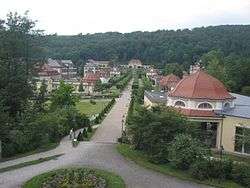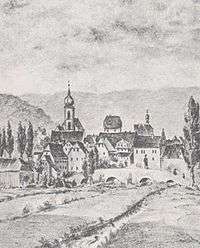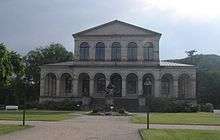Bad Brückenau
| Bad Brückenau | ||
|---|---|---|
 Staatsbad Brückenau | ||
| ||
 Bad Brückenau Location of Bad Brückenau within Bad Kissingen district  | ||
| Coordinates: 50°18′34″N 9°47′26″E / 50.30944°N 9.79056°ECoordinates: 50°18′34″N 9°47′26″E / 50.30944°N 9.79056°E | ||
| Country | Germany | |
| State | Bavaria | |
| Admin. region | Unterfranken | |
| District | Bad Kissingen | |
| Government | ||
| • Mayor | Brigitte Meyerdierks (CSU) | |
| Area | ||
| • Total | 23.73 km2 (9.16 sq mi) | |
| Elevation | 332 m (1,089 ft) | |
| Population (2017-12-31)[1] | ||
| • Total | 6,422 | |
| • Density | 270/km2 (700/sq mi) | |
| Time zone | CET/CEST (UTC+1/+2) | |
| Postal codes | 97769 | |
| Dialling codes | 09741 | |
| Vehicle registration | KG, BRK, HAB | |
| Website | www.bad-brueckenau.de | |
Bad Brückenau (![]()
Geography
Bad Brückenau is located in the valley of the River Sinn, in the western part of the Rhön Mountains. It consists of five subdivisions: the central town Bad Brückenau and the four suburbs Staatsbad Brückenau, Wernarz, Volkers and Römershag.

History
History of Brückenau
The early history of the town is sparsely documented. The first buildings were probably erected close to a ford across the Sinn, which was in use by the time of Charlemagne. By the 12th century the settlement had reached the size of a small town and was called Sinn-Au. Earliest mention of the town is made in a document dating back to 1249, when Fulda Abbey granted Sinn-Au certain privileges. In 1260 the Bishop had four castles built around the town, which he granted to various vassals in the area. Around that time, he also fortified the town with a simple town wall.

In 1310 Sinn-Au was granted the rights of a city by King (later Emperor) Heinrich VII. With that, Brückenau gained the rights to maintain its walls, hold markets, have its own council, cut tree in the forests, raise taxes on wine and so on. In 1337, the council made use of its new rights and enlarged the walls and fortified the gates. In 1597 the town received its present name Brückenau, when a bridge (German: Brücke) was built over the Sinn. In August 1876, the town was almost completely destroyed by fire.
History of the spa
In the 15th century mention is made of a sour-tasting well four kilometers down the valley in south westerly direction. Even then, the water was known for its curative properties, and in 1747 Bishop Amandus von Buseck of Fulda built a fountain. Under his successor Heinrich von Bibra, the first hotels were built and two more wells discovered. The Baroque ensemble along the main axis of the Kurpark dates back to these days.
In 1816, following the Napoleonic Wars, Brückenau became part of the Kingdom of Bavaria. Brückenau became the favorite spa of King Ludwig I of Bavaria, who financed an encompassing renovation. The central building dating back to this era is the Große Kursaal. After the German Revolution of 1848 and the abdication of Ludwig I, the Bavarian government leased the spa to private entrepreneurs. Today, most of the hotels are leased by Dorint.
In the first decade of the 20th century, the town, rebuilt after the fire, began to imitate the success of the spa. Three wells were discovered, the town and a group of citizens created two parks. In the administrative reform of 1970, the Staatsbad became part of the town and all of Brückenau was granted the official title "Bad".
Culture and Sights
Museums
- Heimatmuseum: This museum is located in the town centre and gives an impression of daily life in Brückenau in the 18th and 19th centuries.
- German Bicycle-Museum
Music

- Bayerisches Kammerorchester
- Kurorchester
Architecture
- Großer Kursaal: The Großer Kursaal was planned in 1827 by the Munich architect Johann Gottfried Gutensohn and built by the Brückenau Master Builder Lorenz Hergenröder. Its Neoclassical style influenced the historicist architecture of spas all over southern Germany.
- Altstadt: The old town of Bad Brückenau is home to a number of historic pubs and inns dating back to the 16th century.
- Kloster Volkersberg: The former Franciscan monastery dating back to the 17th century is located in the suburb of Volkers and overlooks the hills of the western Rhön Mountains.
Mayors
- 1998-2010: Thomas Ullmann
- 2010- Brigitte Meyerdierks (CSU) [2]
Town twinning
Bad Brückenau is twinned with:


Notable people
- de:Ernst Putz (1896-1933), member of parliament of the communist party, in 1933 murdered by the Nazis
- de:David Schuster (1910-1999), businessman, member of the Bavarian Senate and chairman of the Jewish Community of Würzburg and Lower Franconia
- Johann Altfuldisch, also Hans Altfuldisch (1911-1947, executed), Obersturmführer and temporarily deputy head of a central part of the Mauthausen concentration camp
- Gerda Müller (born 1944), jurist, vice-president of the Federal Court of Justice 2005-2009
References
External links
| Wikimedia Commons has media related to Bad Brückenau. |
